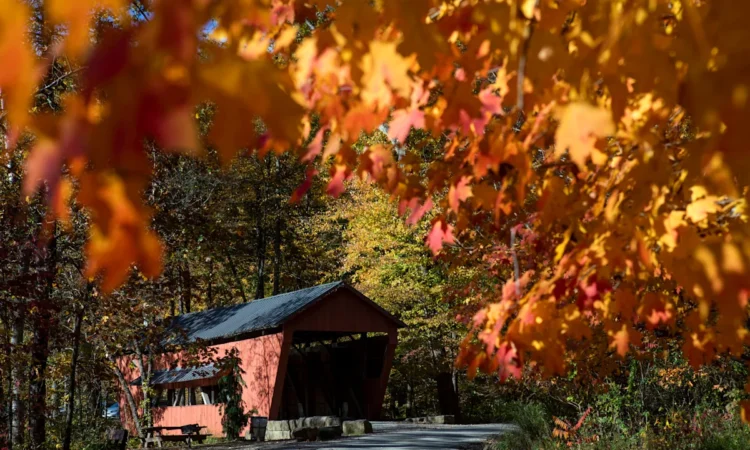‘An odd year.’ Fall color is a little behind schedule in Ohio because of dry, warm weather

The start of the fall coincides with the changing of the leaves and the return of cooler conditions.
But nearly a month into the season, Ohio’s fall color is off pace.
“This has been an odd year,” said David Parrott, a fall color forester for the Ohio Department of Natural Resources. “Typically, we would see the changes starting north and then work down throughout the state. This year, it’s been a little more sporadic.”
Parrott said the dry weather observed in the region has caused some leaves to change color faster than others.
“We’re seeing some species turn in kind of early … primarily due to the dry weather we’ve been having,” he said. “Then we’ve seen kind of a delay in other species where we’ve had the warm weather.”

Peak fall color is on the horizon, according to the Ohio Department of Natural Resources.
With temperatures continuing to drop, the state agency is predicting peak fall color will arrive throughout the state within the next few weeks.
“The fall colors, which seem to be taking their time this year, can now be seen sprinkling through the tree canopies around the state as more seasonable temperatures are on the way,” the department said in a prepared statement.
ODNR maintains a statewide color map at: https://tinyurl.com/yc6uxx23.

Fall colors have begun to pop around Northeast Ohio.
Drought conditions have varying effects on different tree species
Parrott said dry weather can pose unique challenges for different types of trees, as some are less equipped to handle the added stress.
“Some species are more adapted to handle drought better than others,” he said. “When trees get stressed, they usually will turn colors earlier and drop their leaves earlier. … When you get a drought, it’s gonna cause stress to all the trees, but particularly the ones that aren’t as drought tolerant.”
Parrott said some of the trees turning quickly include sycamores, poplars and red maples.
“Our oak species in particular, they’re very drought tolerant, and they don’t seem to be as impacted in terms of how their leaves are reacting,” he said. “In fact, a lot of those seem like they’re almost more delayed, primarily due to the hot weather we’ve been having, and not having those cool evenings to kind of trigger the changes of them.
“Ideally what you’d have is not too wet, not too dry, just kind of moderate precipitation, and then you’d have sunny days, cool evenings, but not below freezing,” he added. “That’s typically the weather we see in the fall.”
When will fall color peak in Northeast Ohio?
Parrott said he’s expecting peak conditions to begin between now and the first week of November at the latest.
“By then, I think most of the leaves are going to be gone, he said. “Theoretically, peak conditions should be like a week away in that area based on prediction models, but I don’t know that we’re necessarily seeing that.
“What we’ve been seeing is that it’s pretty sporadic and localized,” he added. “We’re seeing some areas that kind of have some colors and others that are just completely green, so I think it’s gonna kind of be pretty much like that in any region.”
There are some observed peak conditions popping up already in the Cleveland area, Parrott said.
“In northeastern Ohio and the Cleveland area, kind of northern along the lake, (we’ve) actually got reports of peak color through there,” he said. “Below that, just south on the eastern side of the state below Ashtabula and south of Cleveland, we’re seeing near peak.”
Parrott said Ohio’s state parks and nature preserves are great options for those looking to view fall color.
“We have state forests that are located primarily in the southeastern part of the state,” he said. “We’d recommend that anyone that wants to see fall colors visit any of those ODNR properties.”
This article originally appeared on The Repository: When will Northeast Ohio see peak fall color? What experts say




